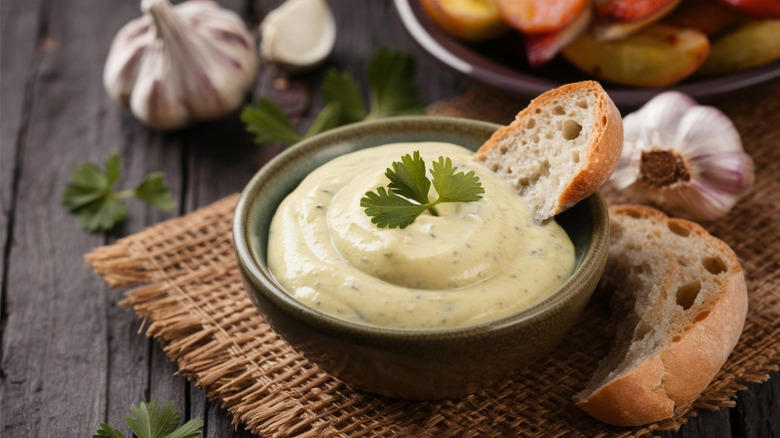The Actual Difference Between Mayo And Aioli
We may receive a commission on purchases made from links.
Mayonnaise and aioli may at first seem to be practically the same. Both are creamy condiments that often appear on sandwiches, in salads, and as dips. Yet, while they share a similar appearance, texture, and common use, the two differ dramatically in flavor. Mayonnaise is believed to have originated in France or Spain. It's made by emulsifying oil with egg yolks, sometimes a touch of mustard, and an acid like vinegar or lemon juice. The result is a smooth, mild sauce that serves as a base for countless recipes. Emulsion is the process of blending two substances that normally resist mixing. This often involves incorporating oil into a water-based ingredient, creating a smooth and stable mixture, which is why you ought to take your time when making your own mayo.
Aioli comes from the Mediterranean region of Provence in France and neighboring regions in Italy and Spain. It's traditionally made of garlic and oil, meaning classic aioli doesn't contain egg yolks, though modern recipes often incorporate them anyway to help stabilize the emulsion. Making homemade mayo or aioli is a snap with a handheld immersion blender like this Vitamix variety.
Spread it on thick, basic or with a kick
The most noticeable difference between mayonnaise and aioli is the taste. Mayo has a neutral, creamy flavor with a slight tang, especially if you choose to incorporate vinegar or mustard. It complements just about everything from turkey sandwiches to potato salads without overpowering the dish. Mayo can serve as a base for spreads, dressings, and dips. It's also often a key ingredient in recipes like coleslaw and deviled eggs and can readily take your scrambled eggs to the next level. Meanwhile, aioli has a bold, distinct garlic flavor. It's often reserved for milder dishes where its unique character can shine, like those incorporating seafood, chicken, or roasted veggies. It likewise adds a gourmet touch to grilled meats, potato dishes, and artisan sandwiches.
Ultimately, your choice between mayonnaise and aioli depends on flavor preferences and what you're preparing. If you want something subtle and versatile, mayo is your go-to. If you want to elevate a dish with a punch of garlic, aioli is the better option. Both have their place and can help you take your culinary creations to the next level.

